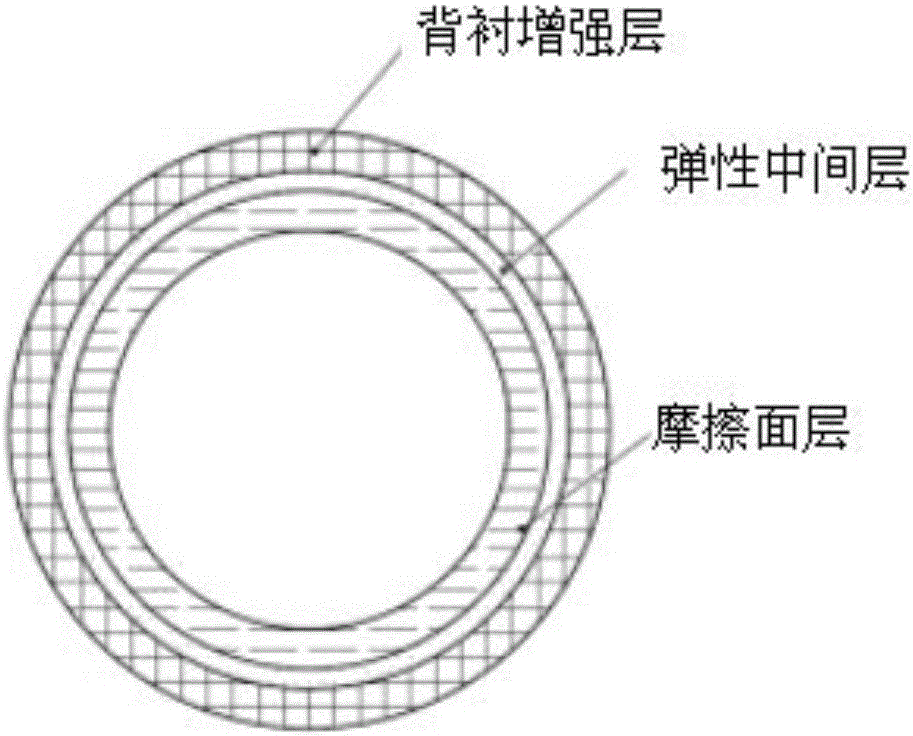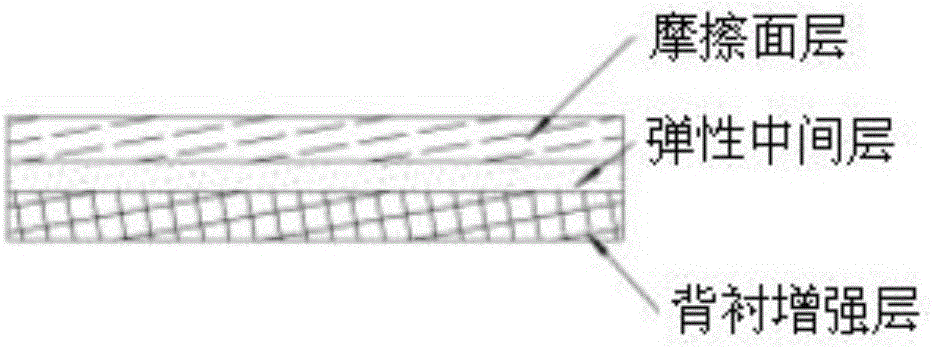Deformation adaptive macromolecule bearing composite material and preparation method and application thereof
A composite material, self-adaptive technology, used in bearing components, shafts and bearings, chemical instruments and methods, etc., can solve the problems of low speed friction coefficient, stick-slip noise, stress concentration bearing damage, etc., to improve wear resistance. , No stick-slip noise, the effect of improving impact resistance
- Summary
- Abstract
- Description
- Claims
- Application Information
AI Technical Summary
Problems solved by technology
Method used
Image
Examples
preparation example Construction
[0034] A method for preparing a deformation-adaptive polymer bearing composite material, the steps are as follows:
[0035] Step 1. According to the requirements of the above-mentioned elastic middle layer, react isocyanate and polyol to obtain polyurethane prepolymer, then use chain extender to perform chain extension reaction with polyurethane prepolymer to obtain a mixture, and then cast the mixture on fiber reinforced resin composite material and cured at 90-130°C for 1-30 minutes to obtain an elastic middle layer;
[0036] Step 2. According to the requirements of the above friction surface layer, mix isocyanate and lubricant evenly, then react with polyol to obtain polyurethane prepolymer, and then use chain extender to perform chain extension reaction with polyurethane prepolymer to obtain a mixture, and then mix the mixture It is poured onto the elastic middle layer, and cured and molded at 90-130° C. for 1-30 minutes to obtain a friction surface layer, that is, to comp...
Embodiment 1
[0040] Preparation of deformation-adaptive polymer bearing composites:
[0041] Such as figure 1 As shown, 1 mol of polytetrahydrofuran polyol (molecular weight 2000g / mol, average functionality of 2) was reacted with 3 mol of MDI at 70°C for 2h to obtain a prepolymer with a mass percentage of NCO groups of 5.6%, and then Use 1.8mol of 1,4-butanediol to perform chain extension reaction with the prepolymer. The reaction temperature is 40°C and the time is 10 minutes to obtain the mixture. Use a centrifuge to pour the mixture onto the outer wall of the glass fiber reinforced epoxy resin cylinder. , to obtain an elastic middle layer with a hardness of 75 Shore A after curing and molding;
[0042] 0.7mol polycarbonate polyol (molecular weight 2000g / mol, average functionality is 2), 0.3mol polypropylene oxide polyol (molecular weight 400g / mol, average functionality 2) and 76g molybdenum disulfide are mixed uniformly, Then react with 5 mol of TDI at 60°C for 3 hours to obtain a pre...
Embodiment 2
[0044] Preparation of deformation-adaptive polymer bearing composites:
[0045] Such as figure 2 As shown, 1 mol of polycaprolactone polyol (molecular weight 2000g / mol, average functionality of 2.2) was reacted with 2.2 mol of PPDI at 70°C for 3 hours to obtain a prepolymer with a mass percentage of NCO groups of 3.9%. body, and then use 0.80mol of 2-methyl-propylene glycol to carry out chain extension reaction with the prepolymer, the reaction temperature is 70 ° C, and the time is 10 minutes to obtain the mixture, and then the carbon fiber reinforced unsaturated polyester fiber board is placed in the mold, and the centrifuge is used to Machine pours the mixture onto the carbon fiber reinforced unsaturated polyester fiber board, and after curing and molding, an elastic middle layer with a hardness of 80 Shore A is obtained;
[0046] 0.2mol polycarbonate polyol (molecular weight 2000g / mol, average functionality is 2), 0.8mol polytetrahydrofuran ether polyol (molecular weight...
PUM
| Property | Measurement | Unit |
|---|---|---|
| Molecular weight | aaaaa | aaaaa |
| Hardness | aaaaa | aaaaa |
| Hardness | aaaaa | aaaaa |
Abstract
Description
Claims
Application Information
 Login to View More
Login to View More - R&D
- Intellectual Property
- Life Sciences
- Materials
- Tech Scout
- Unparalleled Data Quality
- Higher Quality Content
- 60% Fewer Hallucinations
Browse by: Latest US Patents, China's latest patents, Technical Efficacy Thesaurus, Application Domain, Technology Topic, Popular Technical Reports.
© 2025 PatSnap. All rights reserved.Legal|Privacy policy|Modern Slavery Act Transparency Statement|Sitemap|About US| Contact US: help@patsnap.com



